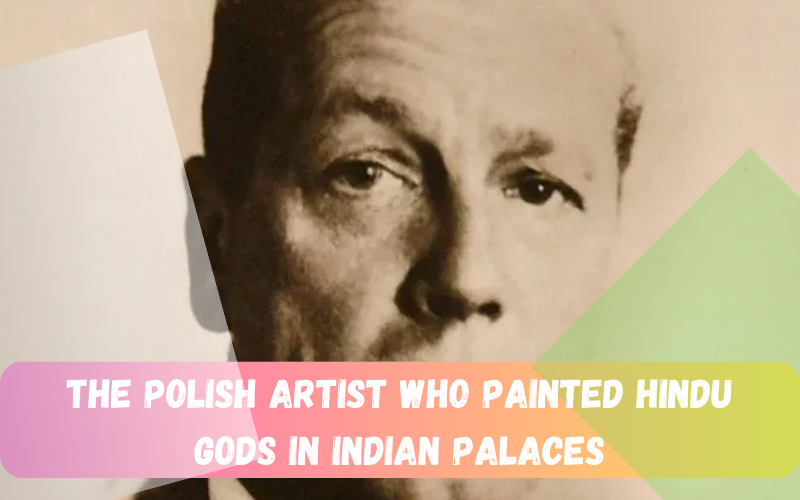In 1939, as German tanks ripped through Poland, the once-comfortable lives of the celebrated Polish painter Stefan Norblin and his glamorous film-star wife, Lena, came crashing down.
Desperation drove the couple to pawn their jewelry, ditch their dream home in Warsaw, and flee for their lives.
They had one hope: to escape to America. But fate had something else in store for them—something more exotic, dangerous, and ultimately iconic.

Stefan and Lena’s harrowing journey took them across war-torn Europe, through Romania, Turkey, and Iraq. But it was in colonial India that their lives would be transformed forever.
From 1941 to 1946, this unlikely duo ended up in the lap of India’s royal maharajas, reinventing themselves in a world full of palaces, palatial intrigue, and ancient legends.
Here, Norblin became a court artist to royalty, creating stunning murals that blended Hollywood-esque glamour, Polish surrealism, and sacred Hindu iconography.
So, how did an exiled painter from Poland leave an indelible mark on the palaces of India’s elite? It’s a tale of high-stakes risk, cultural fusion, and one artist’s bold leap into the unknown.
A Mad Dash into Indian Royalty
When the couple first landed in Bombay (now Mumbai), they found themselves in a world that was as chaotic as it was culturally rich.
Imagine the city in the 1940s: a bustling British-occupied metropolis filled with a dizzying blend of religions, languages, and traditions.
For Norblin, it was a canvas like no other. His European modernist sensibilities, steeped in the art deco style, would soon collide with India’s ancient mythologies, creating an unforgettable fusion that left Indian royals clamoring for his work.

And boy, did he deliver! Soon after his arrival, Norblin was commissioned by Maharaja Mahendrasinhji’s son, who was constructing a new palace in Morbi, Gujarat.
The Maharaja’s son, who had caught the art deco bug while studying abroad, saw in Norblin the perfect artist to bring a sleek, modern aesthetic to the Indian palace.
Norblin dove in, creating murals of epic hunting scenes, brooding portraits of the Maharaja’s ancestors, and hauntingly beautiful depictions of the Hindu god Shiva, deep in prayer.
The human figures in these murals are mystical and ethereal, stretching across the walls like specters from another world.

The Grand Adventure in Umaid Bhawan
But his masterpiece awaited him in the gilded halls of Umaid Bhawan Palace, Jodhpur—a palatial home that looked more like something out of a fever dream than a real building.
When Maharaja Umaid Singh’s order of custom-designed furniture from London sank in a shipping mishap, he turned to Norblin, commissioning him to transform the palace with his artistic vision. And transform it he did.
Norblin’s most electrifying works in the palace were his murals of the fierce goddess Durga.
Imagine her as he painted her: part Hindu deity, part Egyptian queen, draped in shadows, her multiple arms brandishing weapons as she rode a lion into battle.
It’s said that one mural portrays her almost like a phantom, her form streaked across the wall in strokes of black paint, a shadow come to life.
In another, she’s a regal warrior, ready to unleash fury on all who dare cross her. His ability to infuse these traditional Indian subjects with an unmistakably art deco twist left an indelible mark.

Then there’s the legendary Oriental Room, where he brought to life scenes from the ancient Hindu epic, the Ramayana.
Norblin depicted goddess Sita’s abduction by Ravana, her bravery, and her ultimate trial by fire.
His depictions had a surreal quality—light meets dark, and old meets new as he breathes life into Hindu gods and heroes with a style India had never seen before.
And all this while, Norblin seemed to infuse each stroke with the sweeping romance and melancholy of his own exile.
The Forgotten Art, Rediscovered
But like all wild rides, Norblin’s Indian adventure came to an end. In 1946, he and Lena left for America, their dreams heavy with the hope of a fresh start.
They settled in San Francisco, but Norblin found that his mystical, East-meets-West artistic style didn’t mesh well with the local art scene.
He struggled to find commissions, and as his eyesight began to fail him, he fell into a deep depression. Tragically, he took his own life in 1952, unwilling to become a burden on his family.
His art in India lay forgotten, with many murals left to battle the relentless heat, humidity, and neglect.
But like buried treasure, Norblin’s masterpieces resurfaced when Claus-Ullrich Simon, an art historian, rediscovered his works in the 1980s.
Since then, the Polish government has taken steps to restore and preserve them, securing Norblin’s place in history as the daring Polish artist who dared to reimagine India’s gods through a lens of European modernism.
Today, Norblin’s murals in Umaid Bhawan and Morbi’s New Palace are a visual feast, blending the spiritual with the sensual, the traditional with the avant-garde.
His art remains a striking reminder of the sheer power of cultural collision—a testament to what can happen when you take two worlds and meld them into something shockingly, undeniably, beautiful.
Stefan Norblin may have lived and died a tragic figure, but his art lives on, whispering stories of gods and legends, of exiled lovers and kings, and a world that once was—a world where Poland’s lost son found his voice, not in Europe or America, but in the very heart of India’s royal palaces.
Wassup!! Ultraman53 here… Vikram Singh Pratihar. I’m a seasoned blogger, writing publishing and marketing most viral content online and making bucks, big bucks. You may occasionally find boring instead of viral, and wonder if i’m really a VIRAL content creator, but that’s okay, there are a few bad apples here and there. I’m a great one…. – source of information ‘Trust me bro!’

